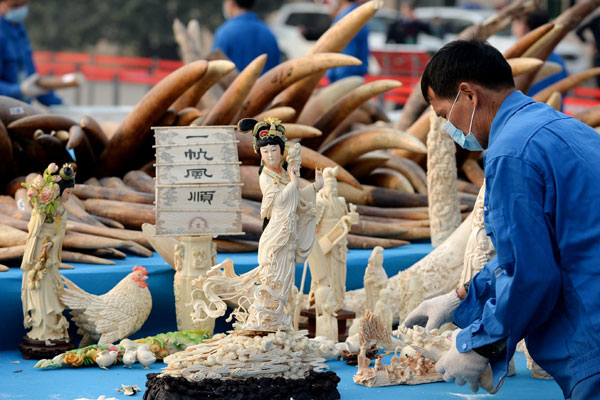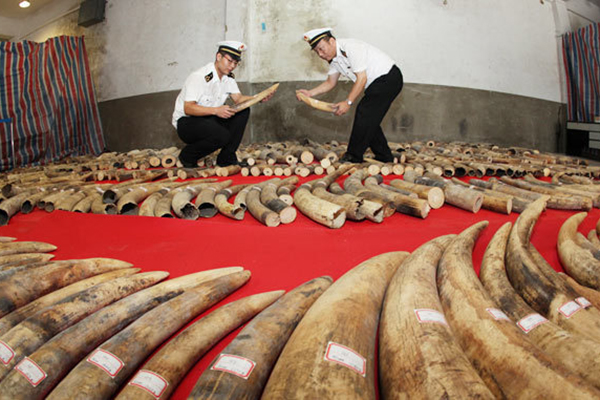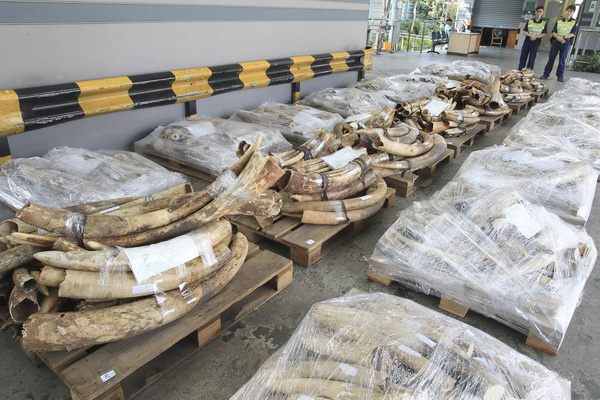
Officers from the State Forestry Administration and the General Administration of Customs, destroy 6.1 ton of illegal ivory items in Dongguan, Guangdong province, ranging from elephant tusks, to smaller carved ivory items, Jan 6, 2014.[Photo by Wang Zhen/Asianewsphoto]
China will impose a one-year ban on the importation of carved ivory items acquired after July 1, 1975.
The ban, which took effect on Feb 26, was announced by the State Forestry Administration, China’s wildlife watchdog.
It only affects ivory acquired after the Convention on International Trade in Endangered Species of Wild Fauna and Flora came into force.

Officers from the State Forestry Administration and the General Administration of Customs destroy 6.1 tons of illegal ivory items in Dongguan, Guangdong province, in January last year. It was the first time China destroyed confiscated elephant ivory.[Photo/Xinhua]
“This action shows China’s commitment to curbing the illegal ivory trade and to protecting African elephants,” said Meng Xianlin, executive director-general of the Endangered Species Import and Export Management Office of China. “The one-year term will also provide time for us to observe and evaluate the actual effect of this act on the elephants.”
“We also hope more policies will be introduced by more countries, especially African ones, that include habitat protection, law enforcement and ivory market management,” Meng said.

Customs officials in Xiamen, Fujian province, make an inventory of smuggled ivory on Nov 4, 2013.[Photo by Lei Guohua/China Daily]
Meng pointed to four sources of legal ivory-international legal ivory stockpile auctions, ivory acquired before 1975, ivory obtained through legal trophy hunting, and legal ivory-carved items obtained after 1975, mainly from Zimbabwe and Namibia.
Between 2010 and 2013, about 100,000 African elephants were killed by poachers, according to a study published in Proceedings of the National Academy of Sciences.
However, official numbers show that the market for ivory in China-both legal and illegal-is shrinking. The number of wildlife smuggling cases last year dropped 70 percent from 2013, and the use of legal ivory for carved products dropped to about 80 percent in recent years.
“The investigation found that the scale of illegal ivory production is way smaller than legal production,” Meng said.

Seized elephant tusks are displayed by customs authorities in Hong Kong in October. Ivory smuggling has fallen due to strict law enforcement in China in recent years[Photo/China Daily]
John E. Scanlon, secretary-general of the Secretariat of the CITES organization, spoke highly of China’s work. It’s not just China’s responsibility, he said. Other countries need to take responsibility for their own plants and animals and take measures to protect them.
“We need support from source, transit and destination countries,” Scanlon said. “China has been dealing with it responsibly as a destination country, showing great leadership through customs and other enforcement departments.
“Source and transit countries should do the same, taking their responsibility seriously and doing what they can. We are in this together.”
